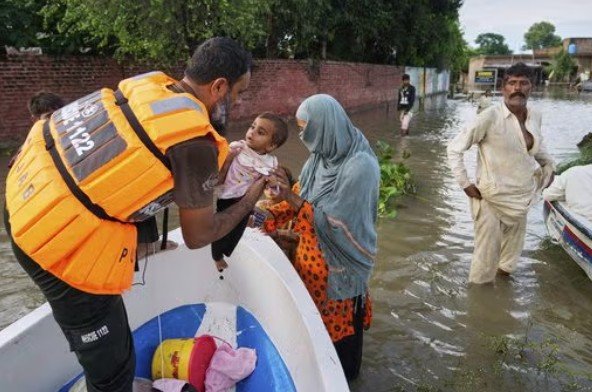
At least 34 people have died and over 210,000 have been displaced as torrential rains pounded parts of Pakistan and India this week, triggering flash floods, landslides, and large-scale evacuations across the region.
The death toll is expected to rise as rescue operations continue.
In Indian-controlled Kashmir, a landslide in the Jammu region killed several Hindu pilgrims late Tuesday after a mountainside collapsed along a popular route to the Vaishno Devi temple in Katra. Authorities confirmed that the bodies of multiple devotees were recovered from the debris, while at least 18 others sustained injuries and were rushed to hospitals. Pilgrimages to the revered temple have been suspended as search operations continue.
Heavy monsoon rains have already killed nearly 100 people in the Himalayan region during August, with more rain forecast in the coming days.
Across the border in Pakistan, floodwaters have inundated villages and swept through eastern Punjab province, submerging the shrine of Guru Nanak—the founder of the Sikh religion—located near the Indian border in Narowal district. The region’s rivers, particularly the Ravi, Chenab, and Sutlej, have risen to alarming levels following a mix of local downpours and water released from overflowing dams in India.
Pakistan’s National Disaster Management Authority (NDMA) said over 210,000 people have been displaced. Lt. Gen. Inam Haider, NDMA chairman, confirmed the army was deployed to aid with relief and evacuation efforts. Tragically, two soldiers lost their lives while assisting victims.
In a desperate measure to save infrastructure, authorities on Wednesday detonated a protective embankment along the Chenab river to prevent the collapse of a nearby barrage. The controlled breach diverted water into nearby villages, forcing hundreds of residents to flee to higher ground and watch helplessly as their homes were swallowed by floodwaters.
Around Lahore, Pakistan’s second-largest city, emergency teams evacuated more than 20,000 people overnight as the Ravi river threatened to overflow. Many of those rescued were living along the riverbed in makeshift settlements, officials said.
Flooding has devastated six districts in Punjab—Kasur, Okara, Bahawalnagar, Bahawalpur, Vehari, and Sialkot. Director-General of the Punjab Disaster Management Authority, Irfan Ali Kathia, warned that the flood situation remains dire with river levels still rising.
In Pakistan’s northwest, more than 150 people are missing and over 300 have died in three villages in the Buner district alone. Since late June, floods have claimed more than 800 lives nationwide.
Scientists have linked the increased severity of monsoon rainfall in South Asia to climate change, which is intensifying seasonal weather patterns. Pakistan’s NDMA chief Haider warned that next year’s monsoon could be 22% stronger, potentially repeating or surpassing the devastation of 2022, when floods submerged a third of the country and killed nearly 1,740 people.
In a rare moment of communication, India officially warned Pakistan earlier this week about the risk of cross-border flooding due to heavy upstream rains—a rare instance of contact between the nuclear-armed neighbors amidst ongoing political tensions.
With more rain forecast across the region, the humanitarian crisis is expected to deepen, as rescue teams race against time to reach stranded communities and prevent further loss of life.
 Weekly Bangla Mirror | Bangla Mirror, Bangladeshi news in UK, bangla mirror news
Weekly Bangla Mirror | Bangla Mirror, Bangladeshi news in UK, bangla mirror news







